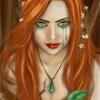Evil is not necessarily a requirement for being a villain, nor is the so called "human-like" qualities, for example SHODAN from System Shock 2 is definitely an effective villain.
In my humble opinion the qualities of an effective villain is as followed:
1)
Presence: The most effective villains are ever present. They make their presence known very early in the game. You can see their minions everywhere. Weak is the villain who arrives on the Facinus Ex Machina Express more than halfway into the game without rhyme or reason.For example:
Irenicus (Baldur's Gate II) - He makes his entrance almost immediately into the game, despite the fact that <CHARNAME> doesn't encounter him until s/he gets to Spellhold, the three dream sequences and two cut scenes keeps Irenicus' presence in the game.
Now compare Irenicus with pathetic villain wanna-bes such as:
Heurodis (Neverwinter Nights: SoU) -
Mephistopheles (Neverwinter Nights: HoU) - "Greetings <CHARNAME>, we haven't met for the first two thirds of the game, so you don't know me. Now I shall turn you into stone/banish you to hell where you can spend the remaining third of the game and there's nothing you can do about it. Furthermore we shall not meet again until the endgame. <Insert Generic Evil Laugh Here>"
It's no contest who is the greater villain. :closedeyes: In short the most important quality of a villain is presence.
2)
It's personal: Not all roleplaying games has a goody-good Paladin as the main protagonist. Thus the inevitable collision between a megalomaniacal villain and the protagonist may not always fit together like a lock and key (especially when the protagonist is an evil or flawed antihero). However, if the villain has some kind of personal vendetta against the protagonist (or at least a reason to act against the protagonist in particular), it makes the conflict protagonist/villain conflict much more interesting. In short, the effectiveness of a villain is very dependent on the worthiness of the villain as an antagonist to the protagonist.For example:
Transcent One (Planescape: Torment) - Now here is a villain who is only interested in the Nameless One (the protagonist), since the Nameless One is the only one who can threaten his existence. The conflict is as inevitable as it is reasonable and fits in nicely with the storyline.
Daggoth Ur (Morrowind) - The protagonist is the prophesied Nerevar Reborn who is being used as a pawn by Azura and Vivec to usurp him, since he cannot act against Azura directly, the only option is the slay the new incarnations of Nerevar.
Now compare the previous two with (I think I'm picking on Neverwinter Nights a bit too much):
Morag (Neverwinter Nights) - Nasher: "<CHARNAME>, here is a pot helmet and a stick. Go kill the lizard queen who you never met before, for your duty to the city to which you've just arrived."

Valsharess (Neverwinter Nights: HoU) - Halaster: "<CHARNAME>, I have forcefully conscripted you into my service, go slay some drow who you never met before because I say so."

Essentially, without the "personal touch," a villain just cannot achieve the potential of all a villain can be. Would Trias the Betrayer be as great a villain if he didn't wrong the Nameless One and simply just told him how to get to the Fortress of Regrets? Not likely.
3)
Motivation: What makes a villain tick? Great villains can come from two extreme polarities, the completely understandable and the completely ununderstandable. What is understandable? For the purposes of argument I define understandable as being more humanlike in nature. Essentially, Lawful Evil villains who have certain quirks (i.e. penchant for sparing the defenseless) are more understandable than Chaotic villains that that simply destroy.Understandable:As human beings we like to delude ourselves by think us as moral species :glare: , thus we can identify more with villains motivated by things such as:
Twisted sense of benevolence - Ex: Trias the Betrayer (Planescape: Torment), The Master (Fallout)
Self preservation - Ex: The Transcendent One (Planescape: Torment)
Twisted sense of justice (i.e. Vengeance) - Ex: Irenicus (Baldur's Gate II), Daggoth Ur (Morrowind)
and less with villains motivated by things such as (though there is some enjoyment in smiting them if playing a goody-two-shoes character):
Pure hatred: Commander Damas (Neverwinter Nights) [I consider him to be a villain for trying to commit genocide

]
Madness for power: Ex: Melissan (Baldur's Gate II:
ToB)
Ununderstandable:What these villains lack in empathy for their plight, they make up for with mystery and horror. These villains kill without hatred, destroy without enjoyment in destruction. In short, psychopathic in nature. Examples of these are SHODAN (System Shock II) and The Overmind (Star Craft), literary examples include Dracula (Bram Stoker) and IT (Stephen King). Of course, these villains must maintain a constant level of Presence to be effective.
4)
Placement and Distribution: Where is the villain on the totem pole of villains? How often and when do you encounter these villains? As in almost all things, timing is essential.Here's an example of what NOT to do:
Neverwinter Nights (Practically a handbook in how NOT to make villains):
Having Aribeth, Maugrim and Morag almost in a row really decreased the effectiveness of all three. Pawns make poor villains: While Aribeth is probably the most effective villain of the three (having a decent Presence and Motivation), making her a pawn of Morag not only decreased her own effectiveness as a villain but also Morag's (who lacks both lacks both Presence and Motivation). Poor Maugrim in the middle practically gets ignored.

By the way, in my opinion, Jarlaxle is Lawful Evil, since he follows his own code of honor (not necessarily in tune with the law of society, but that's the way most Lawful Evil characters are), and dislikes meaningless destruction.













